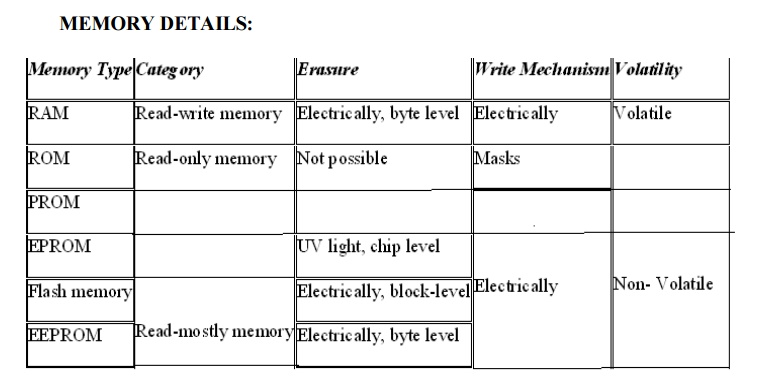Chapter: Digital Electronics : Memory Devices
Types of RAM
Types of RAM:
There are two important memory devices in the RAM family: SRAM and DRAM. The main difference between them is the duration of the data stored. Static RAM (SRAM) retains its contents as long as electrical power is applied to the chip. However, if the power is turned off or lost temporarily, its contents will be lost forever. Dynamic RAM (DRAM), on the other hand, has an extremely short data lifetimeusually less than a quarter of a second. This is true even when power is applied continuously.
In short, SRAM has all the properties of the memory you think of when you hear the word RAM. Compared with that, DRAM sounds kind of useless. What good is a memory device that retains its contents for only a fraction of a second? By itself, such a volatile memory is indeed worthless. However, a simple piece of hardware called a DRAM controller can be used to make DRAM behave more like SRAM.The job of the DRAM controller, often included within the processor, is to periodically refresh the data stored in the DRAM. By refreshing the data several times a second, the DRAM controller keeps the contents of memory alive for as long as they are needed. So, DRAM is as useful as SRAM after all.
When deciding which type of RAM to use, a system designer must consider access time and cost. SRAM devices offer extremely fast access times (approximately four times faster than DRAM) but are much more expensive to produce. Generally, SRAM is used only where access speed is crucial. However, if a system requires only a small amount of memory, SRAM may make more sense because you could avoid the cost of a DRAM controller.
A much lower cost-per-byte makes DRAM attractive whenever large amounts of RAM are required. DRAM is also available in much larger capacities than SRAM. Many embedded systems include both types: a small block of SRAM (a few hundred kilobytes) along a critical data path and a much larger block of DRAM (in the megabytes) for everything else. Some small embedded systems get by without any added memory: they use only the microcontroller's on-chip memory.
Random-Access Memory (RAM)
• Key features
– RAM is packaged as a chip.
– Basic storage unit is a cell (one bit per cell).
– Multiple RAM chips form a memory.
– It is possible to both read data from and write data to memory easily and rapidly.
– Two additional forms of RAM are as follows…
• Static RAM (SRAM)
– Each cell stores bit with inverter, transistor circuit.
– Retains value indefinitely, as long as it is kept powered.
– Relatively insensitive to disturbances such as electrical noise.
– Faster and more expensive than DRAM.
– Access time is about 10 ns
– Used for cache memory
• Dynamic RAM (DRAM)
– Each cell stores bit with a capacitor and transistor.
– Because the capacitors have a natural tendency to discharge, value must be refreshed every 10-100 ms.
– Sensitive to disturbances.
– Slower and cheaper than SRAM.
– Read and write operations are suspended when the refresh cycle is going on, this increases the effective access time to 50ns.
– Used for main memory
Advanced DRAM Organization
• Enhanced DRAM
• Cache DRAM
• Synchronous DRAM
• Rambus DRAM
• Enhanced DRAM
ü Simplest of new DRAM architectures
ü Developed by Ramtron
ü Integrates a small SRAM cache onto a DRAM chip
ü Refresh operation can be conducted in parallel with cache read operation
ü It has separate read path and write path so it enables a subsequent read access to cache in parallel with the completion of write operation.
• Cache DRAM
ü Developed by Mitsubishi
ü Similar to EDRAM, includes a larger SRAM cache than the EDRAM
ü SRAM on CDRAM can be used as either true cache or as a buffer to support the serial access to a block of data.
ü Buffer stores most recently accessed data.
• Synchronous DRAM
ü Jointly developed by no of companies
ü It exchanges data with the processor synchronized to an external clock signal
ü It runs at speed equivalent to that of processor/memory bus without imposing wait states.
ü Data moves in and out from DRAM under the control of system clock.
ü It has dual bank internal architecture
ü SDRAM includes important key features like Mode register and associated control logic. It provides a mechanism to customize SDRAM according to system needs.
ü It performs best when transferring large blocks of data serially, e.g. in word processing, multimedia etc.
• Rambus DRAM
ü Developed by Rambus
ü RDRAM chips are vertical packages, with all pins on one side.
ü fastest current memory technologies used by PCs. Normally SRAM can deliver data at a maximum speed of about 100 MHz, RDRAM transfers data at up to 800 MHz
ü RDRAM is used with Pentium III Xeon processors and more recently it is being used with Pentium 4 processors.

Related Topics